Re-posted from Brian Kelly’s Institutional Web Mangers Workshop (IWMW) blog—prepared on the occasion of IWMW’s 20th anniversary
A brief look back down the road
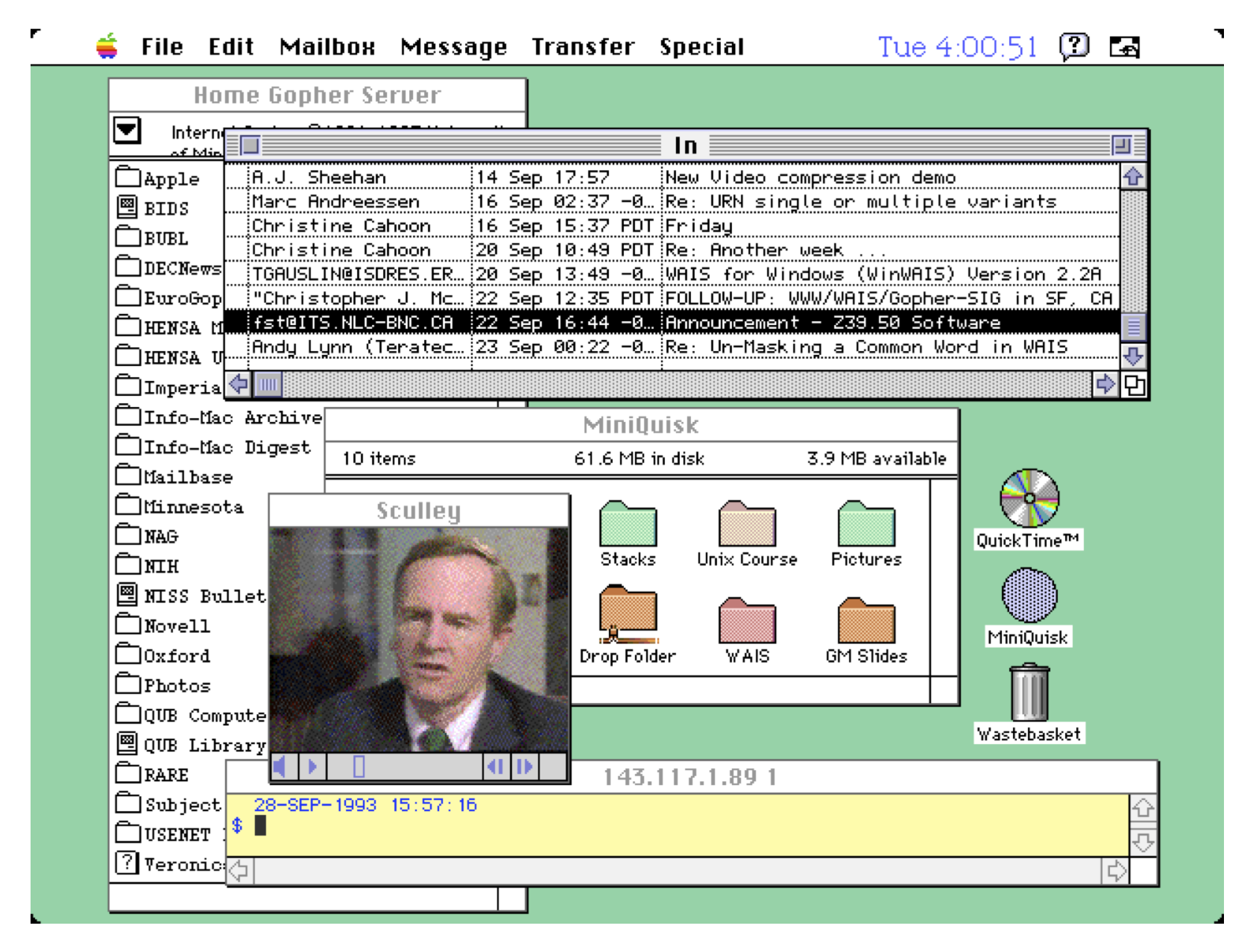
About this guest post
I’ve known Brian Kelly for about 30 years. He is one of those guys with whom I feel instantly at home, with half a universe of common understanding and opinion born from living through the same eras and being excited or concerned by the same developments. We bump into each other at meetings, conferences, deliver the odd workshop together—but never go looking for each other in between, it just happens. So it was at Jisc’s Digifest this year. But of course Brian is not the sentimental old dozer than I am. No sooner had I put my arm round his shoulder with a “good to see you mate” than he was out with “oh, would you like to write a blog post for me” “but sure I only ever took a workshop activity at your IWMW meetings“ “that doesn’t matter, you could mention how things have changed since the early 90s” “no problem Brian!”.
Putting things in perspective
So, what on earth can I share that would be of interest to readers today, in an age where we dip our heads into the fast flowing stream of passing multi-faceted mish mash of bumf, news and information gems, then lift it out gasping for relief from the intake and pay no heed to what else passes in the interim and that never gets a chance to impress on our consciousness because there just isn’t time and space! Hmm… maybe that’s the first thing to say, how email and lists used to be the real source of collaboration and sharing ideas, before the only spam we knew about was in a tin or on Monty Python, how Mailbase (Jiscmail’s predecessor) was revered and productively employed all over the world, how we could have spent an hour or more writing a post, knowing it would be read considerately and responded to with due attention. This social media of the day was focused, quite academic and the pre-runner to the best interactive blogs you’ll find anywhere today. Of course we did have the whole gamut of trivia and serious topics dealt with in the leviathan News that rolled through subscribing sites—but that was always seen as somewhat “recreational”.
Of course everything got a little more exciting with internet information services. I remember playing with what we would now call “intranets” essentially campus information systems (anyone remember CWIS). But as Europe gave way to TCP/IP and the internet started to look like the global network it was to become, the tantalising prospect of information systems that worked across very remote sites, began to form.
Early internet information services


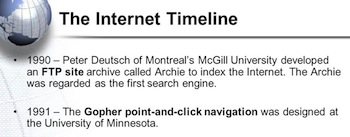
The first and most basic was genius in its simplicity: Archie. All credit to Peter Deutsch and Alan Emtage from McGill University in Montreal. Lots of universities and other sites had anonymous ftp and a list of available files in different directories, so Peter and Alan just compiled a master list, built a trivial search facility around it and let people find what they were looking for in one place rather than having to visit every site. Hats off to you Peter and Alan, you went on to create one of the first true internet companies, Bunyip, above a Dunkin Donuts shop in downtown Montreal, and for years kept sending staff to IETF (Internet Engineering Task Force) meetings contributing to discussions and development that are still guiding our online world.
Then came Brewster Kahle and his Wide Area Information System (WAIS) connecting rich databases across the internet. And for anyone who regards Al Gore as the father of the internet (rather than Vint Cerf) then it is only because Brewster was at his side advising on the potential and encouraging an admirably receptive mind to go forward. Brewster later installed mega storage discs in the Presidio in San Francisco when he developed Alexa, the information engine that Amazon later adopted to match customers to what they might like to buy. Today his “Wayback Machine” archives over 150 billion web pages that have appeared since 1996.
Along with WAIS came what we all thought would be the de facto standard, and it was for a while, Gopher. Plain text and a few images. That was multimedia enough to begin with, and the ease with which “pages” could be created and include “links” to different gopher “sites” globally really did set the scene for more hypertext systems.
At the 1992 Network Services conference in Pisa we heard how Cornell University were trying to provide a standard package of interfaces to internet resources, they called it “Bear Access“. We also had a presentation about Hypertext Markup Language (HTML) but everyone thought this was far too complicated to ever catch on! Not so Tim Berners-Lee and his supportive colleagues, principally Robert Cailliau, at CERN. They were already using a command line interface to something they called web sites made up of HTML pages, and had started to look at graphical versions on Next workstations.
Emergence of the world wide web
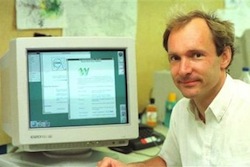
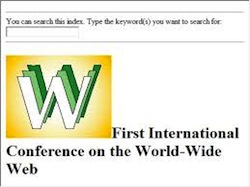
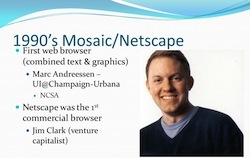

At this time I had been persuaded to head up a TERENA task force to review what a “unifying” desktop computer interface to internet resources could be, and I had established the UNITE (User Network Interface To Everything) discussion list and prompted the interest of a global audience in having a say and dreaming about our ideal “screen to a universe of connected stuff”. We issued a position paper in November 1992, which read a bit like a blueprint for a web browser. In this group was a young, impatient and very talented programmer at Illinois by the name of Marc Andreessen who wanted to know why we just didn’t get on with it… he had already been shaping up something he called Mosaic on expensive Unix graphic workstations.
By the time the 1993 Network Services conference in Warsaw arrived the matter was just about settled. Yes, I gave a talk about UNITE and presented all our views on what the ideal interface was. Yes, we were told about other hypertext systems such as the Austrian Hyper-G and our own Wendy Hall’s Microcosm being developed at Southampton. But when George Brett, director of the Centre for Networked Information Discovery and Retrieval (CNIDR) in the US sat Jill Foster and myself down in the lobby of the Europejski Hotel, with a “wait till you see this” as he pulled out his Mac notebook and fired up Marc’s Mosaic for Macintosh, showing off an early web site that Jim Croft of the Australian National University had compiled (it even included a sound file of a Kookaburra)—that was when I knew the world had just changed… irrevocably!
Mosaic went from strength to strength and Jim Clarke eventually took Marc to the west coast, changing the name of the company from Mosaic Communications Corporation to Netscape later in 1994 (a name we had used to label the next phase of the UNITE ideas in creating the infrastructure required to satisfy user needs identified via the desktop interface). And of course Netscape went on to represent the biggest initial public offering (IPO) in history.
But before that we had, what I had dubbed, the “Woodstock of the internet” in the Spring of 1994 at CERN—the very first World Wide Web conference. And what a party that was. Never had so many leading edge technologists, developers, engineers, game and virtual reality geeks and all other types of luminaries usually involved in changing the world, come together with such expectation. Robert Cailliau’s biggest fear at this first web conference was that the web would become a broadcast medium rather than interactive. And to some extent his fears were certainly valid. But who could deny that Tim Berners-Lee’s infectious enthusiasm stole the show, as it has done ever since.
Spreading the word


I went on to set up a small company in Northern Ireland, in the spirit of Peter and Alan’s Bunyip, called UNITE Solutions. This was only after campaigning fruitlessly within my university that we should create a resource centre for the web and partner with business to develop it’s wealth of opportunities. I was unable to convince certain authorities that the web would become significant. And when I sought support from local economic development agencies outside the university, I was told my ideas didn’t fit into any existing categories and therefore they could do nothing!
In Europe there was a little more open mindedness and we participated in a large multinational Framework IV project, DESIRE, to develop information services in a number of community, educational and business scenarios. At the same time in Northern Ireland many were requesting UNITE’s services as they realised that something big was happening. My “demo” web projects at the university had attracted attention both locally from organisations such as Anthony McQuillan’s Conservation Volunteers, and as far away as the Washington Post (from whence a delegation appeared at the Vice Chancellor’s office one day to learn more about Michael McGrath’s Gaelic Football news site that had attracted a large US audience). In Geosciences we launched the first fully electronic peer reviewed international journal, Brian Whalley’s GGG (Glacial Geology and Geomorphology). We compiled instructional web pages from old 35mm slides of Orthopaedic Surgery scenarios in the BONE (Base for Orthopaedic Expertise) project. And of course we forged down some new inroads, such as getting local politicians to answer questions from the public online, or setting up a web camera in the Crown Bar in Belfast (a first) for expatriates all over the world to view and feel at home (the keyboard got so sticky that we eventually had to change the access password to use only a single key).
Commercialisation
Since those early innovative years I do feel that business has hijacked the internet. In terms of hardware CPU, RAM, storage and bandwidth, we have progressed at a rate that would have seemed incredible back then. But in terms of achieving what should be possible in terms of managing content, we have only scratched the surface. Tim has lamented that we haven’t yet embedded sufficient metadata in web pages to provide the semantics and convey universal context to everything. His remark that he should have called it the Giant Global Graph, GGG, instead of WWW, is so pertinent. I also view with nostalgia old web pages in that simple innocent “Times” font format with blue underlined links and the odd image awkwardly perched to one side. They raise the long ago thoughts that we really had found a common format for sharing information in all possible shapes and forms. It was about information engineering, not gloss and marketing… alas!
The pioneering spirit

However, more than the mild sadness of conceding that a certain amount of lag was inevitable in progressing the web towards our early visions, as the rest of the world on-boarded, I regard with more concern the relative indifference that many “web managers” exhibit compared to the zeal and fervour of early “webmasters”. The concept of a webmaster has changed over the years and evolved into a plethora of organisational roles and functions. Many of the early “web pioneers” will mostly remain nameless, not having clambered onto a social media stage that to them seems too self-promoting compared to the real work of pushing back the frontiers of global networking and related services, the sort of work that has made our current online world possible.
The substance of the workshop I led for Brian at IWMW in 2011 focused on the responsibilities of “institutional web managers” and how contemporary roles compared to the first webmasters. I was disappointed to find attitudes that insisted a web manager should be cautious and not “waste” time on new technologies (the example at the time was HTML5) until such technologies had been properly tried and tested by others! Today I am regularly flabbergasted at the genuine ignorance nursed by some web managers when it comes to matters of how the web actually works and what it can and should do for them. Some seem to even regard it as their duty to discard discussion about technology as it could conflict with their views of how a web site or application should work!
And now—service is being resumed, brace yourself

Am I disheartened… resoundingly “NO”. Behind today’s facade of online torrents of individual experience minutiae there’s still a wealth of first class blogs in the spirit of the old email lists, which actually still survive in many Jiscmail and other fora also, despite email being plagued by spam. But more than that, there are still real webmasters around too. Often they’re the jacks of all web trades and masters of many, perhaps a bit risk averse, feared by authorities, thinking they can change the world a little and just getting on with it. Tim Berners-Lee’s GGG is not dead, it’s growing every day; embedded metadata is becoming more of a standard; the World Wide Web Consortium that Tim created is bigger than ever and co-ordinates web related development globally with every bit as much clout as the Internet Engineering Task Force (IETF) has coordinated the underlying network protocols over the years. We have only dipped our toe in the possibilities unfolding, enabled by the web and all its derivatives. Progress is inevitable. The value of a real webmaster is higher than ever. The compunction for web managers to think things through properly has never been more, and the risk they must face is not embracing change but ignoring or missing it!
